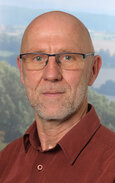Project
Partial deep tillage

Reduction of the environmental and climate impact of the cultivation of raw material plants by using the benefits of partial deep tillage (PDT)
How can the cultivation of crops be made more climate-friendly? The "Krumensenke" project, a joint project of the Thünen Institute for Agricultural Technology (TI-AT) and the Leibniz Centre for Agricultural Landscape Research (ZALF), will investigate the potential of partial deep tillage.
Background and Objective
The aim of the "Krumensenke" project is to find out whether the technology of meliorative, partial deep tillage (PDT) can be optimised with the aid of an interdisciplinary research approach in such a way that the production of crops can be made less climate-effective in the long term. In combination with site-specific soil cultivation methods, PDT methods will be developed and tested. Furthermore, the short- and long-term potential of a PDT for additional carbon and nitrogen storage in soils is to be quantified, as well as the reduction of greenhouse gas emissions and nitrogen emissions and their effects on plant growth and yield. In this way, an overall ecological and economic evaluation of the developed process is possible.
Approach
The overall goal will be achieved by investigating the following subgoals:
1. precise assessment of the short- and medium-term influence of partial crumb deepening in the case of different soils in connection with the form of N-fertilization on the climate effect and the C- and N-storage in soil (model test)
2. estimation of the long-term effect of partial crumb deepening on C-storage
3. development of a method for the area-sharp estimation of the C-storage potential
4. the development and testing of meliorative solutions and methods specific to the individual parts of the project, partial crumb deepening
5. economic and ecological evaluation of methods of partial crumb deepening
6. estimation of the potential for a partial deepening of the crumb in Germany
Reduction of the climate impact and increase of C-storage
7. deriving recommendations for the design of optimized procedures for partial crumb deepening in the cultivation of raw material plants.
Our Research Questions
1. Which scenarios need to be considered in order to assess both the economic and environmental benefits of PDT? Which reference scenario(s) are assumed for the crop rotation to be investigated at the different locations?
2. How high are the additional costs of PDT compared to conventional tillage (reference scenario at the respective location)? How are the additional costs distributed between investment, fuel and labour costs?
3. What influence do short and long-term yield losses or yield increases have on farmers' profits when they use PDT? When will the break-even point for PDT be reached at the different locations?
4. PDT results in increased fuel consumption and therefore additional greenhouse gas emissions. Are those offset by the change in tillage and the resulting increase in carbon storage in the soil? How long must the carbon be stored at least a) to compensate for the increased greenhouse gas emissions from the modified tillage, and b) how high is the area-related reduction of greenhouse gas emissions depending on the temporary carbon storage in the soil?
5. What is the intensity of greenhouse gases per product unit? How high are the greenhouse gas abatement costs?
Thünen-Contact

Involved external Thünen-Partners
- Leibniz-Zentrum für Agrarlandschaftsforschung (ZALF) e.V.
(Müncheberg, Deutschland)
Funding Body
-
Fachagentur Nachwachsende Rohstoffe e.V. (FNR)
(national, öffentlich)
Duration
3.2019 - 12.2023
More Information
Project funding number: 22040918
Funding program: FNR
Project status:
finished
Publications on the project
- 0
Stichnothe H, Carrillo Quijano C (2024) Fractional deep tillage of arable soils to reduce harmful environmental and climate impacts in crop production. Braunschweig: Thünen Institute of Agricultural Technology, 2 p, Project Brief Thünen Inst 2024/17a, DOI:10.3220/PB1717659244000
- 1
Stichnothe H, Carrillo Quijano C (2024) Partielle Krumenvertiefung von Ackerböden zur Reduktion schädlicher Umwelt- und Klimaauswirkungen in der Getreideproduktion. Braunschweig: Thünen-Institut für Agrartechnologie, 2 p, Project Brief Thünen Inst 2024/17, DOI:10.3220/PB1717658999000

![[Translate to English:] [Translate to English:]](/media/_processed_/3/6/csm_Hintergrund-Ausschnitt1_9daaef6b89.jpeg)
![[Translate to English:] [Translate to English:]](/media/_processed_/3/6/csm_Hintergrund-Ausschnitt1_0bd7111163.jpeg)




